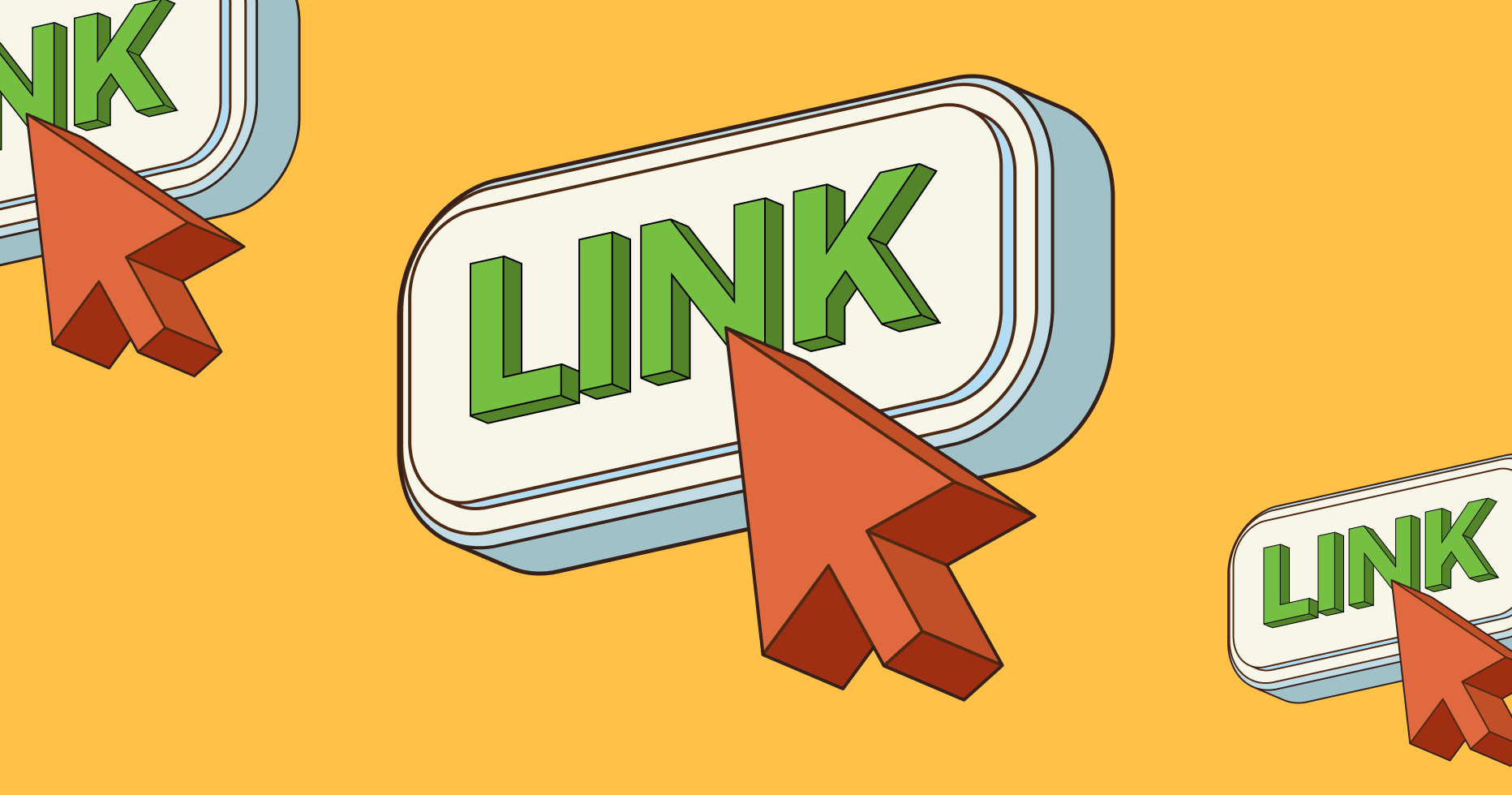How to Place Affiliate Links Efficiently
Before we delve more deeply into the art of using affiliate links to drive tons of conversions and revenue, let’s have a quick look at how they work.
So, what is an affiliate link and how do affiliate links work?
Affiliate links are special URLs containing the ID or username of the affiliate. They are used for tracking affiliate performance and giving them credit for affiliate sales. While some marketers say that affiliate links are their most powerful money-making tool, others complain that all their efforts go waste because these links are useless.
You may ask: How do I put affiliate links on my website to optimize my campaigns and drive better results? Here’re some tried-and-tested strategies on how to use affiliate links to bring out their full potential.
1. Integrate Links Logically
Don’t use affiliate links to hard sell. Make sure they are relevant to the ideas in the post and serve as a logical extension to them. Your links should come across as a useful personal recommendation.
It’s also vital to create a logical lead to all your affiliate links by explaining how your readers will benefit from clicking them.
For example, Matthew Karsten, an avid traveler and owner of the Expert Vagabond blog, created an overview of the best backpacks for various types of travelers and embedded affiliate links to the backpacks he considers worth buying. This type of post is a win-win. Readers get expert advice that help them with a purchasing decision, while Mat enjoys the affiliate commissions rolling in.
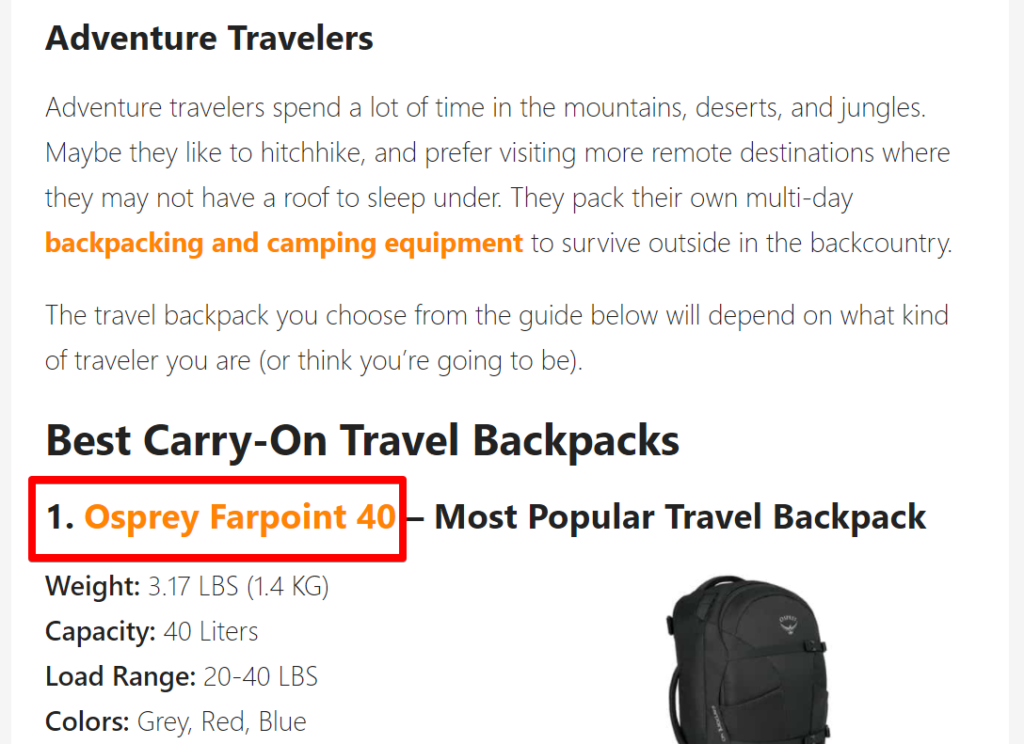
Another example to illustrate this technique can be found on the post about How to pack for the Camino de Santiago by Audrey Scott, the owner of the Uncornered Market blog. Audrey shares actionable tips and recommends the best products to make your travel experience seamless and unforgettable. He also embeds affiliate links to the products to help readers pack light for the trip and manages to convert affiliate links into one word or a short phrase.

2. Not Enough or Too Many Links
It’s also crucial to maintain balance and use the right number of affiliate links in your content. Sometimes, affiliates go to extremes and overload their content with affiliate links. This makes content looks spammy and may put some readers off. However, if you use affiliate links too sparingly, your audience might not pay attention to them and you’ll leave money on the table.
So, what do you need to do to strike the right balance? The best practice is to write content that provides value to your audience and solves some of their pain points. By employing this strategy, affiliate links appear natural and create a seamless user experience. For example, Kristin, the owner of the Be My Muse Blog offers her readers the Ultimate Backpacking Checklist, in which she recommends her favorite clothing, gear, food, etc. and manages to seamlessly include affiliate links into the text.
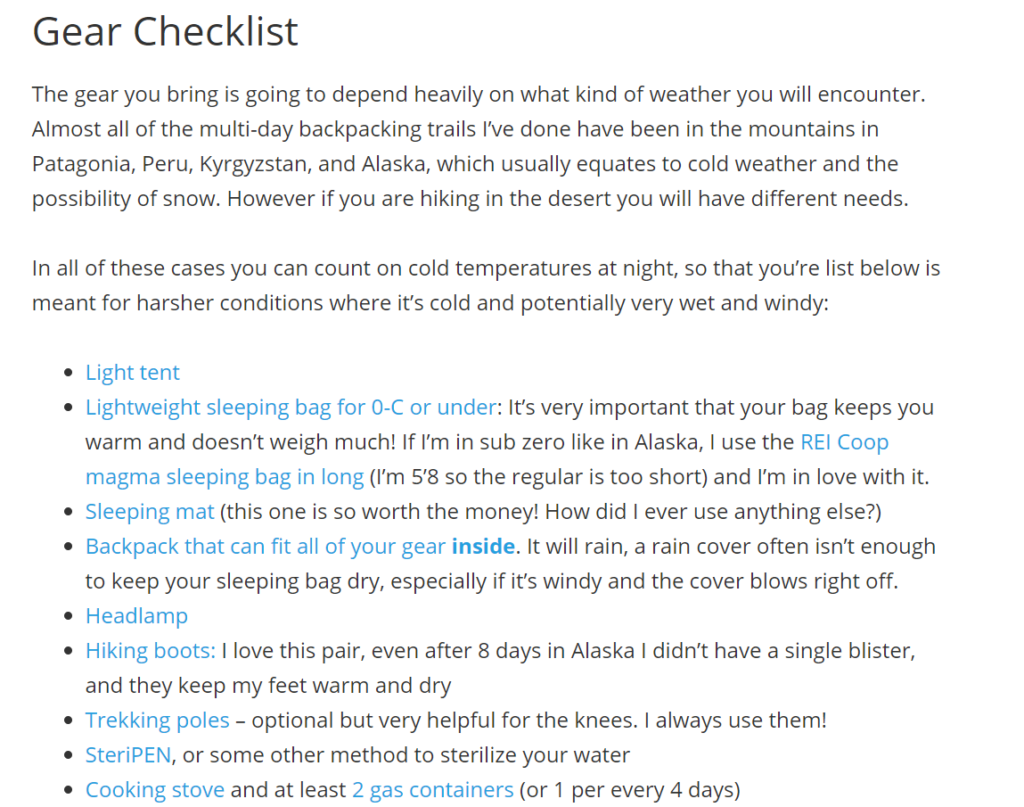
3. Add Links as One Block at the End of the Post
If you promote several affiliate products in one post, you can also save readers the trouble of scrolling up and down by presenting all your affiliate links in one block at the end of the post.
For example, in an article called 15 Awesome Things To Do In Mexico’s Yucatan Peninsula, Matthew Karsten places affiliate links in the Resources Section at the bottom of the page.

4. Highlight Links in Bold or a Different Color
Affiliate links must also be attention-grabbing and click-enticing. So, make sure your affiliate links stand out. Use bright colors or bold fonts to highlight your links and garner more attention, as Melissa Giroux does in her blog A Broken Backpack.
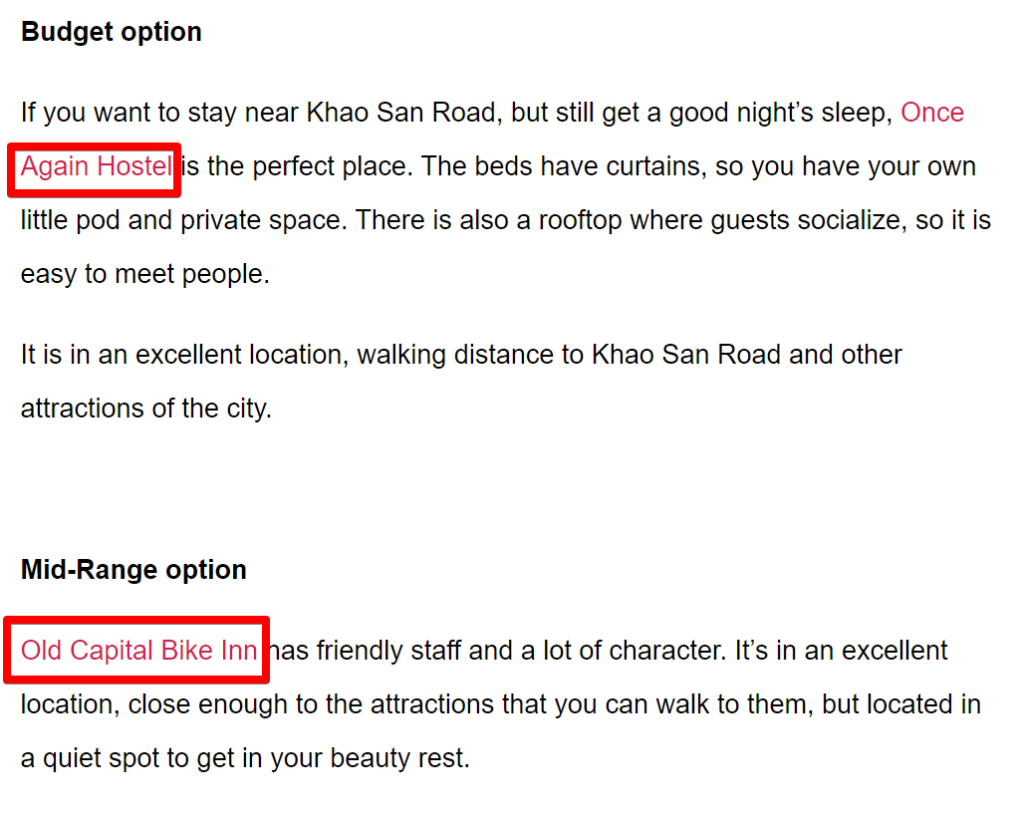
5. Link to the Offer, Not the Homepage
When promoting a product/service or giving recommendations, make sure you create deep links and direct users to the page for that specific offer. This will save your readers a lot of time and boost the conversion rate.

6. Use CTA Buttons
To drive more conversions, remember to encourage your readers to take a specific action. To do so, craft many different attention-grabbing CTAs and incorporate them into your content. These can be CTA buttons, text-only CTAs, CTA images, or a combination to achieve the best possible results.
It’s also important that your CTAs align with your goals and post content. For example, if you need more traffic, you can incentivize your readers to share your posts on social media.

Want to promote a digital product? Explain its benefits and motivate your readers to purchase or download it as Nomadic Matt does in his blog posts.
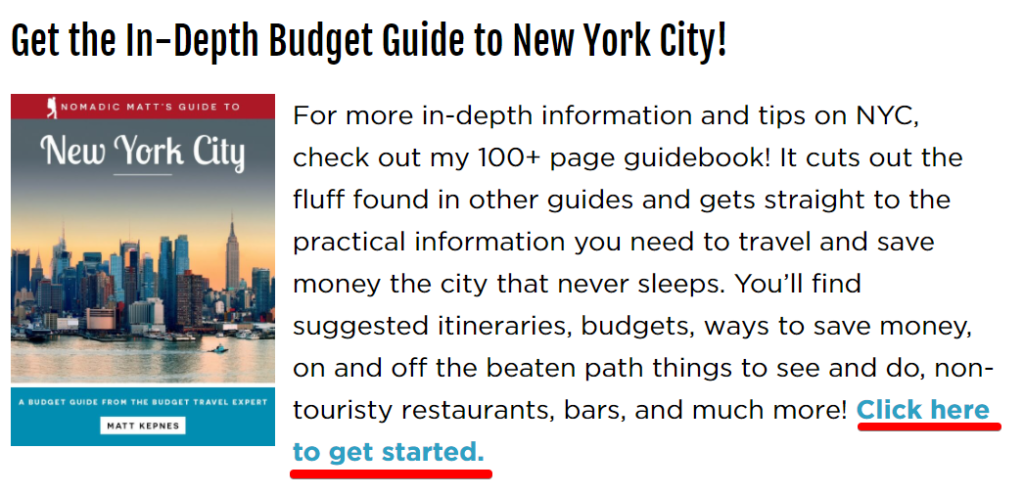
7. Cloak Your Links
As a rule, affiliate links are quite long and not extremely pleasing to the eye. This is why it’s better to use affiliate link cloaking to make your links appear cleaner, shorter, and more visually appealing. However, this is not the only benefit to reap from link cloaking. Here are some other advantages:
- Cloaking can protect links from being stolen.
- A short, good-looking link is easier to share.
- Link cloakers can make link management a piece of cake.
The web offers loads of software for link cloaking, such as the Pretty Links Plugin, Thirsty Affiliates, WooCommerce, etc.
8. Shorten Your Links
If you’re working with partner programs through Travelpayouts, you don’t need to use third-party services to shorten links, because the platform has its own built-in URL shortener. You only need to open the «Link Generator» tool on the page of the selected program and fill in the required fields. After that, the generator will return a short affiliate URL, which:
- Doesn’t contain technical parameters. Only the brand name and eight characters after the slash. Your ID will be contained in a short link, but hidden from users.
- Have a high level of trust. Travelpayouts’ short links contain the name of the chosen travel brand, which has a positive effect on conversion.
9. Add Links to Your Most Effective Posts
As a blogger, you know which posts and content types perform best with your audience. If you don’t, make sure to track your statistics and identify which posts garner a lot of attention. Then, add affiliate links to the most popular.
Why should I add affiliate links to my website’s top-ranking posts? The reason is simple. The more eyes you get on your content and tools, the higher your conversion rate will be. Embedding affiliate links in top-performing posts guarantees a steady flow of traffic to those links, which will lead to increased revenue.
10. Diversify Link Placement
Blog posts are not the only place to post your affiliate links. So, what are some other choices?
- Within images in blog posts. Images are extremely click-enticing, so don’t miss the chance to drive more clicks by adding clickable visuals to your posts. You may be wondering: How can I embed affiliate links in pictures to put on my website? This post explains how to use personal images as affiliate links and answers another common question: How do you add a Shareasale link to your website?
Josh, the creator of the California Through My Lens Blog, makes the images in his Resources section clickable to make it easier for his readers to find the products he recommends.
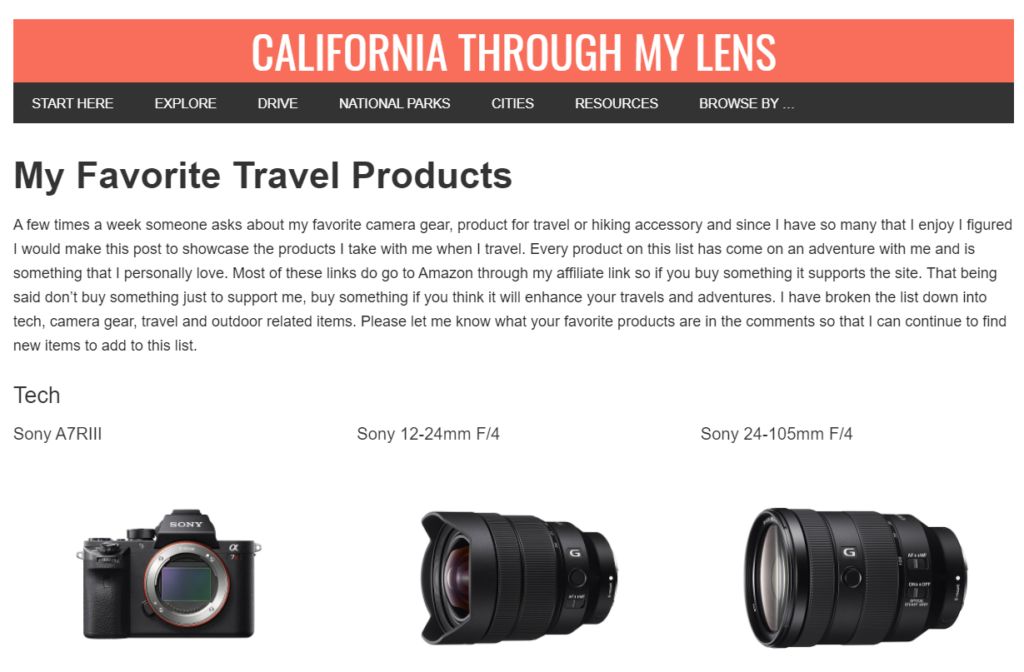
- Within digital products or inside your courses. When creating a digital product, such as an eBook, guide, or course, think about which products and services can best make your readers’ life easier and add affiliate links to them.
For example, the Backpacker Banter Planning guide provides top money-saving tips for travelers and shares affiliate links for accommodations, travel insurance, surfing gear, etc.

- In the comments. Communicate with your audience and offer affiliate links as an effective way to tackle their problems.
- In reviews. Reviews are a place to promote affiliate links. You can review and compare one or several products, as Matthew Karsten does in his Travel Tripod review.
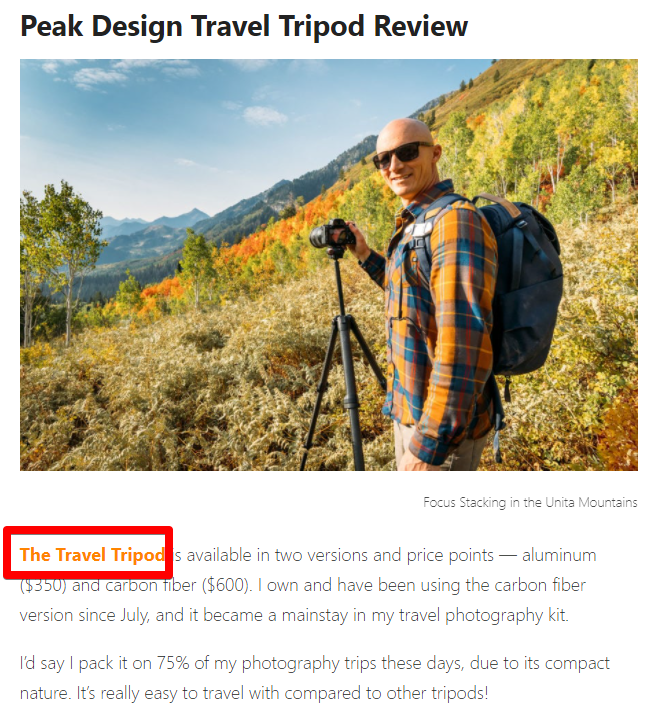
- On social media. Using social media for your affiliate campaigns can skyrocket their performance, as social media helps you engage directly with your audience. Though you can do affiliate marketing on almost every social media platform, some are more suitable than others. Discover the best tips for promoting affiliate links on Facebook, Instagram, Pinterest, Twitter, Telegram, Snapchat, YouTube, etc.
- Within tables. Tables are a great way to compare and highlight the pros and cons of different products. Tables help readers make purchasing decisions and allow you to promote multiple affiliate links. For example, on the IndieTraveller blog, the author offers a table to give the readers a quick overview of the best backpacks for travel.

- On your About or Travel Resources page. It’s great to have a Resources page on your blog so that your readers know where they can always find all the products and services you speak highly of. For example, the BreatheDreamGo travel resources page features tours, services, and other travel products that the bloggers find useful and recommend to their audience.
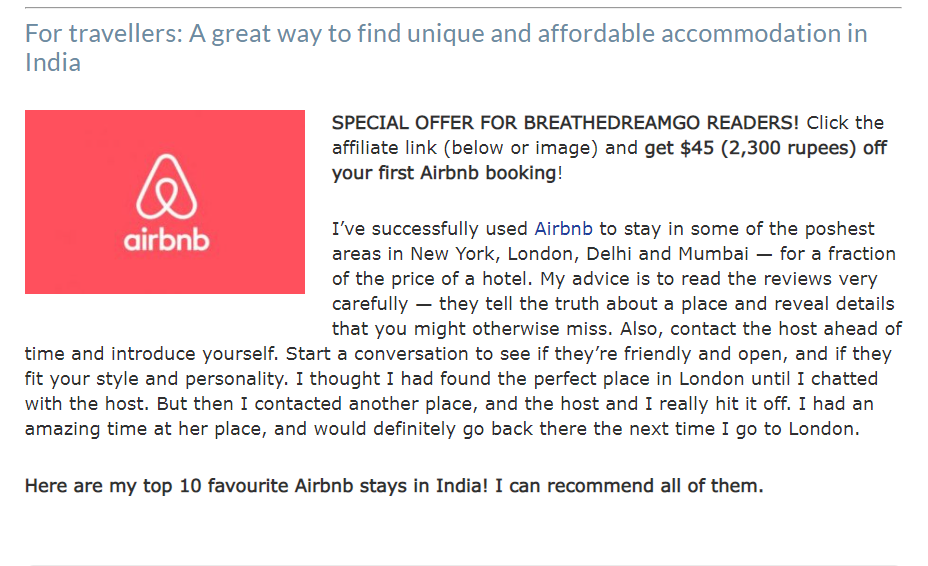
11. Make Sure You Disclose Affiliate Links
Audience trust is one of the underlying factors determining the success of your affiliate campaigns. To build rapport, it’s vital to be crystal clear that you’re involved in affiliate relationships.
Besides, link disclosure is a legal requirement. To steer clear of any legal or reputational trouble, make sure you are open about your affiliate relationships and disclose all affiliate links. This post teaches you how to properly disclose affiliate links.
12. Place Other Tools as Well
When choosing promo tools, it’s best to keep your options open and leverage a wide range of tools in your affiliate campaigns. People perceive information differently. While some of us are likely to click affiliate links within a block of text, others pay more attention to compelling banners or interactive widgets. Thus, it’s vital to combine different tools and techniques to identify which approaches perform best with your audience.
For example, in his post on the reasons to get travel insurance, Drew Binsky uses both affiliate links and banners to promote a travel insurance company.

Download our guide on placing affiliate tools to get expert tool placement tips, maximize your marketing efforts, and tweak your campaigns for success.
How to Put Affiliate Links on My Website?
We’ve shared the most actionable tips on how to incorporate affiliate links on your website and use them to their maximum potential. However, a lot depends on your project, audience, and niche. The best strategy is to combine different tools and tactics, gauge your results, and see what resonates with your audience the most.
Remember that, in addition to finding the perfect link location, it’s also important to monitor their performance, as some links may contain typos while others may lead to errors. To avoid doing this manually, install LinkSwitcher. This tool analyzes URLs on your webpages and displays any invalid links in your Travelpayouts account. Learn more about LinkSwitcher in our article.

